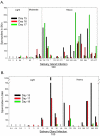Quantitative dynamics of Plasmodium yoelii sporozoite transmission by infected anopheline mosquitoes
- PMID: 15972531
- PMCID: PMC1168603
- DOI: 10.1128/IAI.73.7.4363-4369.2005
Quantitative dynamics of Plasmodium yoelii sporozoite transmission by infected anopheline mosquitoes
Abstract
Malaria transmission begins with the injection of Plasmodium sporozoites into the skin of a vertebrate host by infected anopheline mosquitoes. Although the size of the sporozoite inoculum likely affects the course of the disease, the number of sporozoites injected by infected mosquitoes has not been determined in vivo. Using a quantitative PCR assay, we determined the number of sporozoites injected into mice by single mosquitoes. Analysis of 59 mosquito feedings showed that a single infected mosquito injected between 0 and 1,297 sporozoites, with a mean of 123 and a median of 18. Twenty-two percent of infected mosquitoes injected no sporozoites. The number of sporozoites injected was only weakly correlated to the salivary gland load. To better understand the large variability in sporozoite injection among mosquitoes, we quantified the sporozoites injected by individual mosquitoes on three different days. Approximately 20% of moderately to heavily infected mosquitoes injected few to no sporozoites on all 3 days, suggesting that some mosquitoes are poor transmitters of sporozoites. Other mosquitoes injected high numbers of sporozoites on at least one of the days observed and minimal numbers on the other day(s), supporting the hypothesis that sporozoite injection is discontinuous, a pattern that may aid in the establishment of malaria infection.
Figures




References
-
- Beier, J., J. Davis, J. Vaughan, B. Noden, and M. Beier. 1991. Quantitation of Plasmodium falciparum sporozoites transmitted in vitro by experimentally infected Anopheles gambiae and Anopheles stephensi. Am. J. Trop. Med. Hyg. 44:564-570. - PubMed
-
- Beier, J. C., M. S. Beier, J. A. Vaughan, C. B. Pumpuni, J. R. Davis, and B. H. Noden. 1992. Sporozoite transmission by Anopheles freeborni and Anopheles gambiae experimentally infected with Plasmodium falciparum. J. Am. Mosq. Cont. Assoc. 8:404-408. - PubMed
-
- Beier, J. C., F. K. Onyango, J. K. Koros, M. Ramadhan, R. Ogwang, R. Wirtz, D. K. Koech, and C. R. Roberts. 1991. Quantitation of malaria sporozoites transmitted in vitro during salivation by wild Afrotropical Anopheles. Med. Vet. Entomol. 5:71-79. - PubMed
-
- Boyd, M., and W. Stratman-Thomas. 1933. Studies on benign tertian malaria. The clinical characteristics of the disease in relation to the dosage of sporozoites. Am. J. Hyg. 17:666-685.
-
- Bruna-Romero, O., J. C. Hafalla, G. Gonzalez-Aseguinolaza, G. Sano, M. Tsuji, and F. Zavala. 2001. Detection of malaria liver-stages in mice infected through the bite of a single Anopheles mosquito using a highly sensitive real-time PCR. Int. J. Parasitol. 31:1499-1502. - PubMed
Publication types
MeSH terms
Grants and funding
LinkOut - more resources
Full Text Sources
Medical

